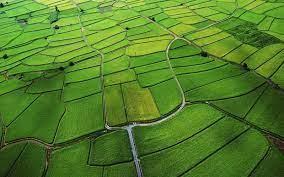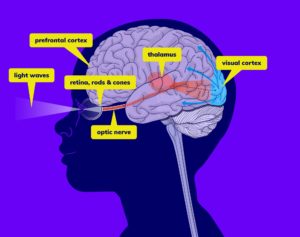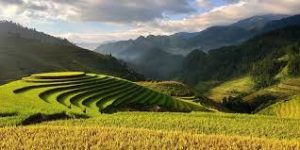
Art Therapy
“One of the basic rules of the universe is that nothing is perfect. Perfection simply doesn’t exist…..Without imperfection, neither you nor I would exist” ― Stephen Hawking




I do not know if it is because it is Summer, and everything is green around here, or I was always attracted to the amazing number of shades of green the fields around here display. The crops are just starting to cover the fields, each one in a different green. This afternoon it was raining again, and looking out the window at the trees and plants, I was struck again at the shades of green. Even some leaves on the Hoya plants indoors display different shades. The amazing thing is that we actually are able to distinguish with our eyes the colours and their shades. How exactly are we able to know what we actually see?
The retina has two main types of photoreceptor cells, rods and cones. These cells play a crucial role in detecting and transmitting visual information to the brain, enabling us to perceive light and colour. Cones are responsible for colour vision and visual acuity in brighter light conditions (photopic vision). There are three cones, each with a different sensitivity to certain wavelengths of light, corresponding roughly to the colours blue, green, and red. These cones are called S-cones (short-wavelength-sensitive), M-cones (medium-wavelength-sensitive), and L-cones (long-wavelength-sensitive), respectively. The combination of signals from these cones allows us to perceive our environment’s wide range of colours. Cones are densely packed in the central region of the retina called the fovea, which provides us with high-resolution vision and fine details.
 Many years ago, when our children were still fairly young, they met at the Jewish community centre Hanukah book sale a stranger. He was in his 60s, and blind. He came from Palo Alto, was a researcher who lost his sight as a result of scientific experimental accident years earlier. He came home with us, and amazed us by his ability to detect colour by touch. He could even detect patterns like a plaid material and its colour. I guess since he had sight before, his tactile acuity became somehow connected to the areas of the brain which detected colour transmitted by the retina. For a few days we had children walking around with scarves tided around their eyes, to try and feel how it is to be blind. Needless to say, they were never able to sense colour with their fingers.
Many years ago, when our children were still fairly young, they met at the Jewish community centre Hanukah book sale a stranger. He was in his 60s, and blind. He came from Palo Alto, was a researcher who lost his sight as a result of scientific experimental accident years earlier. He came home with us, and amazed us by his ability to detect colour by touch. He could even detect patterns like a plaid material and its colour. I guess since he had sight before, his tactile acuity became somehow connected to the areas of the brain which detected colour transmitted by the retina. For a few days we had children walking around with scarves tided around their eyes, to try and feel how it is to be blind. Needless to say, they were never able to sense colour with their fingers.
When I paint, it is totally different. It is the various pigments which create the desired colour. All the shades are a result of mixing various amounts of the 3 basic colours and black and white. Red Yellow and Blue are the ones that are the base of all the hundreds of colours and shades we can create, and which the eye translates to the hues we recognize, and we give names to the colour we arrive at. In order to create the shades of green I saw in the fields I will mix blue and yellow in various amounts, testing each to see if it is the shade I observed in nature on the field. You can see here my attempt in transmitting onto the paper the memory of the colours I saw in the fields on a recent Sunday afternoon drive.
 As a therapist I often relate colour to mood and feelings. It can even be a litmus paper of their well being at the particular moment in their life. I ask clients to chose a colour for their various feelings they describe and recognize in themselves. The colour green is almost never associated with sad or depressed feelings. Most likely association is to feeling alive, hopeful and growth. In fact, when there is a drawing of despair, pain and feeling anger the drawings are usually including black, red, grey and sometimes brown and generally what we perceive as “darker” looking images. One of the ways I work is to ask the person if he/she is able to change the image to what they are hoping to achieve. Most of the time the colour green yellow and blue appear in their various shades. The amazing thing is that when the person actually looks at the changed image they did, their internal feelings also change, and they feel better. Perhaps we can learn from that and chose to look at art that includes bright and green images, go out to nature and get inspiration from growth and colour during the spring, summer and fall, and even find inspiration outdoors during the winter.
As a therapist I often relate colour to mood and feelings. It can even be a litmus paper of their well being at the particular moment in their life. I ask clients to chose a colour for their various feelings they describe and recognize in themselves. The colour green is almost never associated with sad or depressed feelings. Most likely association is to feeling alive, hopeful and growth. In fact, when there is a drawing of despair, pain and feeling anger the drawings are usually including black, red, grey and sometimes brown and generally what we perceive as “darker” looking images. One of the ways I work is to ask the person if he/she is able to change the image to what they are hoping to achieve. Most of the time the colour green yellow and blue appear in their various shades. The amazing thing is that when the person actually looks at the changed image they did, their internal feelings also change, and they feel better. Perhaps we can learn from that and chose to look at art that includes bright and green images, go out to nature and get inspiration from growth and colour during the spring, summer and fall, and even find inspiration outdoors during the winter.
 The Green Revolution, also known as the Third Agricultural Revolution, was a period of technology transfer initiatives that saw greatly increased crop yields and agricultural production. These changes in agriculture began in developed countries in the early 20th Century and spread globally till the late 1980s. We found out gradually that it was not as green as it was sold to us, and in effect it actually was the industrialization of agriculture and created much damage to our planet and the diversity of plants, and gradually introduced the genetically modified plants and the use of poisonous chemicals into our food chain.
The Green Revolution, also known as the Third Agricultural Revolution, was a period of technology transfer initiatives that saw greatly increased crop yields and agricultural production. These changes in agriculture began in developed countries in the early 20th Century and spread globally till the late 1980s. We found out gradually that it was not as green as it was sold to us, and in effect it actually was the industrialization of agriculture and created much damage to our planet and the diversity of plants, and gradually introduced the genetically modified plants and the use of poisonous chemicals into our food chain.
The word green is associated these days with environmental issues. The advertisement industry is pushing the “Buy Green” movement. What you see on TV is the ad s pushing the same products they tried to convince us to buy before, only now they are trying to convince us that the product was produced by using sustainable agricultural methods, green energy, green labour practices, green, green, green. The idea is correct, we need to take care of the environment, to make sure we do not exploit resources, to have humane labour practices and make sure there are no pesticides in our food. How can we find balance? How can we take care of the environment without exploiting the issue for commercial gains? Is there actually an official body that can be trusted to check the claims of advertisers? What about food packages that boast being green? How can we trust labels on clothing that claim it is a green product? Raw materials are mined by exploiting mineral rights of aboriginal people. How green is that? And how green will be our valleys when we use up and exploit the trees, minerals, and water?
 Some progress is being made by asking the right questions about industrial agriculture versus sustainable agriculture. Some of the solutions are arrived at by creating programs like Sustainable Agriculture Research Education . the goal is to meet society’s needs in the present without compromising the ability of future generations to meet their needs. Sustainable agriculture seeks to integrate three main objectives into their work: a healthy environment, economic profitability, and social and economic equity. Every person involved in the food system—growers, food processors, distributors, retailers, consumers, and waste managers—can play a role in ensuring a sustainable agricultural system. Each segment of the population has a role to play in making sure we keep our practices green. Competing interests of the individual and the global community may cause conflicts we need to solve. Keeping a balance between the interests without compromising the basic principles challenges us sometimes to walk on a tightrope. The ability to negotiate the tightrope walk without falling necessitates practice. Sometimes we need to have aids, or preparations that will change the rope into a road which we need to traverse. Perhaps we need to spend some time to change the rope to a bridge which will allow communities or groups of people to cross together, helping each other. Our survival depends on cooperation and accepting
Some progress is being made by asking the right questions about industrial agriculture versus sustainable agriculture. Some of the solutions are arrived at by creating programs like Sustainable Agriculture Research Education . the goal is to meet society’s needs in the present without compromising the ability of future generations to meet their needs. Sustainable agriculture seeks to integrate three main objectives into their work: a healthy environment, economic profitability, and social and economic equity. Every person involved in the food system—growers, food processors, distributors, retailers, consumers, and waste managers—can play a role in ensuring a sustainable agricultural system. Each segment of the population has a role to play in making sure we keep our practices green. Competing interests of the individual and the global community may cause conflicts we need to solve. Keeping a balance between the interests without compromising the basic principles challenges us sometimes to walk on a tightrope. The ability to negotiate the tightrope walk without falling necessitates practice. Sometimes we need to have aids, or preparations that will change the rope into a road which we need to traverse. Perhaps we need to spend some time to change the rope to a bridge which will allow communities or groups of people to cross together, helping each other. Our survival depends on cooperation and accepting 
hues of all colours into our picture.